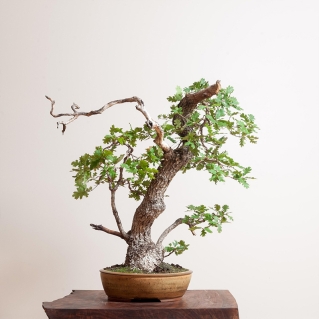Rocky Mountain Juniper Bonsai

General Information
Rocky Mountain juniper—Juniperus scopulorum—is by far the highest quality North American juniper bonsai species. One of the most unique features of the Rocky Mountain juniper is its fine foliage mass.
Although the best juniper species in the world, Rocky Mountain juniper require a unique handling technique—the fine foliage makes it a more delicate species and requires a lot of technical capacity to work with.
The foliage mass creates a very tightly-grained, fine vascular system in Rocky Mountain juniper. When you combine that with the blowing sand and aggregate of the windy high prairie, high desert, and rocky mountain environments, you get an incredibly textured, fine detailed, sandblasted deadwood and contrast of living and dead tissue that is unrivaled in the world of juniper species.
Although delicate to work with from a technical sense, Rocky Moutain junipers are very strong and durable.

Caring for Rocky Mountain Juniper Bonsai
Watering
Rocky Mountain junipers are a species that utilize a large amount of water since they have a fine root system that maintains their fine foliage mass.
The exception to this is when they have been freshly pruned. When a juniper has been freshly pruned, has sparse foliage mass, or has suffered a setback and lost some foliage mass, it does not utilize nearly as much water and it is vital that you let it completely dry out between waterings to avoid overwatering.
Sun Exposure
Rocky Mountain juniper thrives in full sun, but will adapt to partial shade.
Temperature
Rocky Mountain juniper is very cold tolerant and very heat tolerant when in bonsai containers.
They can thrive in temperatures well over 100 degrees. They can tolerate temperatures in terms of cold down to around 15-10 degrees Fahrenheit before we start to see branches being lost and root damage occurring.
Rocky Mountain juniper function at a far higher rate of success, density, compactness, and strength when they have very warm summers and very cold winters—full sun during both of these seasons will give you the highest productivity for a Rocky Mountain juniper bonsai.
Pruning
For structural styling, cultivators should prune a Rocky Mountain juniper bonsai prior to the plush growth in the spring—but it’s important to remember that because the species' strength comes from its foliage mass, you never want to reduce that mass by more than 60 percent.
When cultivating a juniper, the goal is to manage the strength of growth by pruning at the correct time of year to ensure finer, more compact growth.
Pruning can be done as the growth begins to harden, generally at the beginning of June in the northern hemisphere. If the tree needs more density and strength, or you are trying to build secondary branching, it is best to let the tree elongate into mid-summer, to let it build that extra bit of energy and foliage mass.
Once the species begins to have the desired accomplishments—more thickening, elongation, or root development, let the species run into early fall.
Timing is everything when it comes to pruning a Rocky Mountain juniper. Choosing the right time gives the foliage mass the time it needs as a running juniper to amass the density, energy, and strength from the foliage mass, to drive growth forward, and perpetuate health in the different stages of development.
Repotting
Rocky Mountain juniper has an incredibly fine and delicate root system. When repotting, we have to be very delicate when handling the roots, because they survive off of the production of roots in response to moisture.
Never bare root the species and always leave a portion of the roots untouched. When repotting Rocky Mountain juniper bonsai, be sure to never over chopstick or over-reduce the foliage mass around the roots. sure to concentrate all efforts on being able to increase the percolation of water and oxygen to the sheen of the species.
After repotting, metabolic activity is key. Temperatures need to be 42°F or higher and you must maintain a balance of water and oxygen and allow the roots to dry thoroughly between waterings.
To help Rocky Mountain juniper thrive after repotting, bottom heat is vital.
Propagation
Rocky Mountain junipers can be effortlessly propagated via air layering or from grafting cuttings—but can even be propagated from seed.
Pests/Disease
One of the most common pests to cause problems for Rocky Mountain junipers is bores. Boring beetles feed on the living tissue and in the live veins of the species, creating a lot of deadwood—which occasionally adds to the beauty and the drama, but can impede the cultivation of this beautiful tree.
Additionally, Rocky Mountain junipers commonly deal with:
● Cercospora Twig Blight; and
● Root Rot
Rocky Mountain Juniper Bonsai FAQS
No junipers have sensitive roots—but the strength of the Rocky Mountain juniper comes from the foliage mass, so we do not want to pinch or overprune the species. When the foliage mass is managed correctly, you’re providing the species with a strong battery, which is what allows the roots to constantly recover.
No, Rocky Mountain juniper should not be pinched at any time—this takes away from their battery of energy and opens them up to susceptibility.
In order for the interior foliage mass of a Rocky Mountain juniper to gain any density, you have to let its foliage elongate.
Once it does gain density, and the foliage is in an energy positive state, it is important to prune the tips back in order to transition that new energy to the interior density. This is vital in ensuring that the juniper does not shed its branches and attempt to become a bigger tree.







